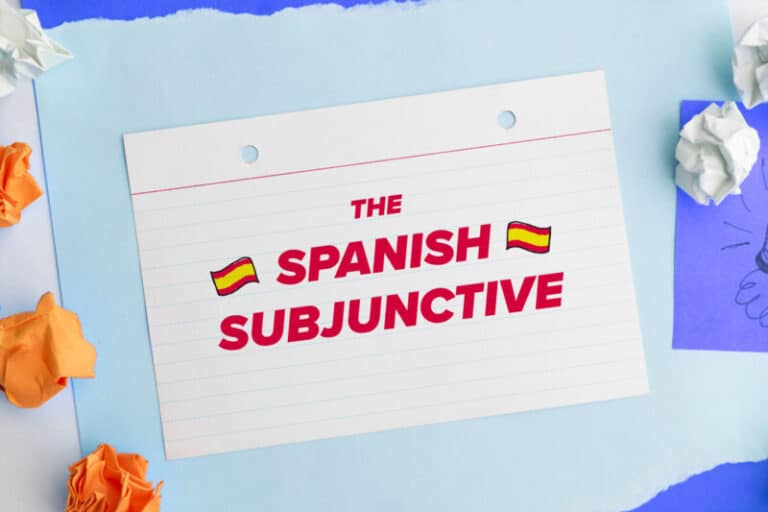The Spanish Imperfect Subjunctive (Conjugation, Uses and Examples)

The Spanish imperfect subjunctive helps you express opinions, hopes, denials, doubts and hypothetical situations—something I’m sure you do a lot in English, just maybe without realizing it.
You can already use the preterite and imperfect tenses, plus the present subjunctive. Now you want to learn how to express yourself fully and confidently in Spanish, so it’s time to learn the imperfect subjunctive.
Download: This blog post is available as a convenient and portable PDF that you can take anywhere. Click here to get a copy. (Download)
What is the Spanish Imperfect Subjunctive?
The imperfect subjunctive is simply the past version of a subjunctive!
As with the present subjunctive, the past subjunctive is triggered when we talk about opinions, hopes, denials, doubts and hypothetical situations, and we have two clauses with different subject nouns.
The only difference is that now we’re talking about the past.
How to Conjugate the Imperfect Subjunctive in Spanish
1. Take the ellos form (third-person plural) of the preterite.
bailar ⇒ (ellos) bailaron
poder ⇒ (ellos) pudieron
2. Remove the -on from the end.
bailaron ⇒ bailar–
pudieron ⇒ pudier–
3. Add the ending from the following table:
| Subject | Ending |
|---|---|
| Yo | -a |
| Tú | -as |
| Él/Ella/Usted | -a |
| Nosotros | -amos |
| Vosotros | -ais |
| Ellos/Ellas/Ustedes | -an |
For example:
bailar ⇒ (ella) bailara
pudier ⇒ (ella) pudiera
Also, you’ll be glad to know that it doesn’t matter if the verb is regular or irregular, this way of conjugating will always work.
You can also use the past perfect in the subjunctive the same way as in the indicative past perfect by conjugating the verb haber and adding the past participle (-ado, –ido form) as we’ll see below.
The Alternate Conjugation of Spanish Imperfect Subjunctive
While the above -ra endings are the most common form of the imperfect subjunctive and the ones I’d recommend learning first, you’ll sometimes see -se endings instead, especially in Spain.
The meaning is the same.
If you want to do the alternate conjugations, start with the ellos form again, but this time remove the last three letters, –ron, and add:
| Subject | Ending |
|---|---|
| Yo | -se |
| Tú | -ses |
| Él/Ella/Usted | -se |
| Nosotros | -semos |
| Vosotros | -seis |
| Ellos/Ellas/Ustedes | -sen |
So these would look like:
bailar ⇒ (ella) bailase
pudier ⇒ (ella) pudiese
When to Use the Imperfect Subjunctive in Spanish
1. Talking about the past
The difference between using the imperfect subjunctive to talk about the past instead of one of the indicative tenses (such as the preterite or imperfect) is that you’re talking about a past hypothetical, doubt, emotion or a “past action before another past action.”
You can use the past perfect in the subjunctive in the same way as in the indicative past perfect—by conjugating the verb haber and adding the past participle (-ado, –ido form).
For example:
Le impresionó mucho que hubieras tomado clases de baile. — She was very impressed that you had taken dance classes.
No conocía a nadie que trabajara en esa compañía. — I didn’t know anyone who worked at that company.
2. Talking about the present
It may seem odd, but we can also use the imperfect subjunctive after como si (meaning “as if”) to talk about the present. If it makes you feel any better, we also often use our (disappearing) English subjunctive in this context.
This is how you’d say things like, “as if…”
For example:
Baila contigo como si ya fuera tu amante. — She is dancing with you as if she were already your lover.
Ella está viviendo como si fuera la reina. — She is living as if she were the queen.
3. Talking about hypotheticals
A clause in the imperfect subjunctive can be coupled with a clause in the conditional to talk about fantastic, unlikely situations (not necessarily in the past).
This also seems a bit weird until you realize we follow the same pattern in English.
The construction you’ll see below is si + imperfect subjunctive clause (the if-only-it-were-so clause), conditional clause (the how-things-would-then-be clause).
Si yo fuera muy rico, ella estaría todavía conmigo. — If I were very rich, she would still be with me.
Si yo supiera bailar tango, podría reemplazarla con cualquiera. — If I knew how to dance tango, I would be able to replace her with anyone/whomever.
4. When using certain verbs in past or conditional tense
Certain verbs will often trigger the imperfect subjunctive when it’s in the second clause.
That means you know to use the imperfect subjunctive in Spanish if you see these in the first part of the sentence (and they’re conjugated in the past or conditional tense).
Here are some of those verbs:
| Verb | Meaning |
|---|---|
| Agradecer | To thank |
| Alegrarse | To be happy |
| Desear | To wish |
| Encantar | To be delighted |
| Enojar | To be angry |
| Esperar | To hope |
| Estar triste/contento/etc. | To be sad/happy/etc. |
| Insistir | To insist |
| Molestar | To bother |
| Necesitar | To need |
| No creer | To not believe |
| Pedir | To ask that |
| Preferir | To prefer |
| Quejarse de | To complain |
| Querer | To want |
| Sorprender | To surprise |
5. To express desire, wishes and doubt
Like the normal subjunctive tense, the imperfect subjunctive is used to express things like desires, wishes and doubts.
It can be used to talk about these things both in the past and in the present (as we saw above in number 2). But when discussing present feelings, think of it as saying “would [do something]” in English.
For example:
Ojalá que fuéramos a la playa mañana. — I hope that we would go to the beach tomorrow.
Dudaba que ellos se hubieran ido. — I doubted they had left.
6. For politeness with querer
The imperfect subjunctive helps you express sentiments like “I would like…” using the verb querer (to want).
It makes your requests sound more polite and is an excellent substitute for the more straightforward Spanish command form.
For example:
Quisiera dirigir el grupo para este proyecto. — I would like to lead the group for this project.
It’s important to note that this is only with the verb querer: when using other verbs, you should use the conditional to make polite requests. For example Me gustaria una naranja (I would like an orange), or Me encantaría salir con él (I’d love to go out with him).
7. Current opinions on past events
The imperfect subjunctive comes in handy when you remember something that happened in the past and still have feelings or opinions about it now.
It’s great for making reflections and complaints.
For example:
Quería que compraras flores para mi cumpleaños. — I wanted you to buy flowers for my birthday.
Dudo que hiciera tanto frío como dijiste. — I doubt it was as cold as you said.
How to Practice the Spanish Imperfect Subjunctive
It can be difficult to understand when to use the imperfect subjunctive. If you’re struggling with this, using other resources can help you grasp it more quickly.
- Practice the imperfect subjunctive by speaking. Especially speaking with a native Spanish speaker will help you incredibly as you can hear how they use it and they can give you feedback on your usage. You can find a language exchange partner on multiple apps, such as the ones we listed here.
- Listen to as much authentic content as possible. FluentU is a good resource for this, as it has over one thousand Spanish videos that can show you how words and grammar structures (like the imperfect subjunctive) are used in context.You can also check out the FluentU Spanish YouTube channel to get an idea of how it works, plus free lessons. For example, this video uses a Spanish-dubbed episode of “Grey’s Anatomy” to teach you meaningful vocabulary, grammar, expressions and cultural context:
FluentU takes authentic videos—like music videos, movie trailers, news and inspiring talks—and turns them into personalized language learning lessons.
You can try FluentU for free for 2 weeks. Check out the website or download the iOS app or Android app.
P.S. If you decide to sign up now, you can take advantage of our current sale!

And here’s one from “The Big Bang Theory”:
- Subscribe to podcasts. Podcasts such as Lightspeed Spanish and Coffee Break Spanish will give you even more listening practice. For a full list of Spanish podcasts for all levels, check out our post here.
And there you have it—the complete rundown on the Spanish imperfect subjunctive.
Learning the imperfect subjunctive won’t always be easy, but you can always improve with lots of practice!
With these tips, you’ll be well on your way to communicating your desires, doubts, opinions and requests with confidence and like a native speaker.
Download: This blog post is available as a convenient and portable PDF that you can take anywhere. Click here to get a copy. (Download)
And One More Thing…
If you've made it this far that means you probably enjoy learning Spanish with engaging material and will then love FluentU.
Other sites use scripted content. FluentU uses a natural approach that helps you ease into the Spanish language and culture over time. You’ll learn Spanish as it’s actually spoken by real people.
FluentU has a wide variety of videos, as you can see here:

FluentU brings native videos within reach with interactive transcripts. You can tap on any word to look it up instantly. Every definition has examples that have been written to help you understand how the word is used. If you see an interesting word you don’t know, you can add it to a vocab list.

Review a complete interactive transcript under the Dialogue tab, and find words and phrases listed under Vocab.

Learn all the vocabulary in any video with FluentU’s robust learning engine. Swipe left or right to see more examples of the word you’re on.

The best part is that FluentU keeps track of the vocabulary that you’re learning, and gives you extra practice with difficult words. It'll even remind you when it’s time to review what you’ve learned. Every learner has a truly personalized experience, even if they’re learning with the same video.
Start using the FluentU website on your computer or tablet or, better yet, download the FluentU app from the iTunes or Google Play store. Click here to take advantage of our current sale! (Expires at the end of this month.)








